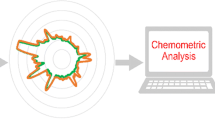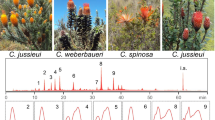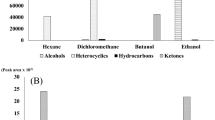Abstract
The aim of this study was to evaluate the potential compositional differences among different populations of H. officinalis subsp. aristatus (Godr.) Nyman. The plant specimens were collected in different locations in Western Balkans (Kosovo and Albania) and subjected to phytochemical profiling (GC–MS for their essential oils and HPLC-UV-DAD for fingerprinting of their solvent extractable phytochemicals). Antioxidant capacity, total flavonoid and phenol contents were measured using different assays. Out of the five location considered, the specimen from one location displayed significant differences both in terms of essential oil composition and of polyphenolic total content. The electronic nose measurements used to characterize their aromatic profile, was able to clearly discriminate the accessions, indicating a good correlation, in particular, with the marked chemotypic difference established by essential oil profiling (1,8-cineol vs. isopinocamphone/camphone). H. officinalis subspp. aristatus (Godr.) Nyman may constitute an interesting subject for further studies on the effect of genetic and environmental factors, or of their combinations, on its chemotypic expression and sensorial properties.




Similar content being viewed by others
References
Dragland S, Senoo H, Wake K, Holte K, Blomhoff R (2003) Several culinary and medicinal herbs are important sources of dietary antioxidants. J Nutr 133:1286–1290
Steinmetz MD, Tognetti P, Morgue M, Jouglard J, Millet Y (1980) Sur la toxicité de certaines builes essentielles du commerce: Essence d’hysope et essence de sauge. Plantes Méd Phytothérap 14:34–35
Özer H, Şahin F, Hamdullah Kılıç H, Güllüce M (2005) Essential oil composition of Hyssopus officinalis L. subsp. angustifolius (Bieb.) Arcangeli from Turkey. Flavour Fragr J 20:42–44
Zawiślak G (2013) The chemical composition of essential hyssop oil depending on plant growth stage. Acta Sci Pol Hortorum Cultus 12:161–170
Moro A, Zalacain A, Hurtado de Mendoza J, Carmona M (2011) Effects of agronomic practices on volatile composition of Hyssopus officinalis L. essential oils. Molecules 16:4131–4139
Kizil S, Toncer O, Ipek A, Arslan N, Saglam S, Khawar KM (2008) Blooming stages of Turkish hyssop (Hyssopus officinalis L.) affect essential oil composition. Acta Agric Scand Sect B 58:273–279
Kizil S, Hasimi N, Tolan V, Kilinc E, Karatas H (2010) Chemical composition, antimicrobial and antioxidant activities of Hyssop (Hyssopus officinalis L.). Essent Oil Not Bot Hort Agrobot Cluj 38:99–103
Fraternale D, Ricci D, Epifano F, Curini M (2004) Composition and antifungal activity of two essential oils of Hyssop (Hyssopus officinalis L.). J Essent Oil Res 16:617–622
Garg SN, Naqvi AA, Singh A, Ram G, Kumar S (1999) Composition of essential oil from an annual crop of Hyssopus officinalis grown in Indian plains. Flavour Fragr J 14:170–172
Salvatore G, D’Andrea A, Nicoletti M (1998) A pinocamphone poor oil of Hyssopus officinalis L. var. decumbens from France (Barton). J Essential Oil Res 10:563–567
Hatipoğlu G, Sökmena M, Bektaş E, Daferera D, Sökmen A, Demir E, Şahina H (2013) Automated and standard extraction of antioxidant phenolic compounds of Hyssopus officinalis L. ssp. angustifolius. Ind Crops Prod 43:427–433
Baj T, Kowalski R, Swiatek L, Modzelewska M, Wolski T (2010) Chemical composition and antioxidant activity of the essentials oil of hyssop (Hyssopus officinalis L. ssp. officinalis). Ann UMCS Pharmacia 23:55–62
Venditti A, Bianco A, Frezza C, Conti F, Maleci Bini L, Giuliani C, Bramucci M, Quassinti L, Damiano S, Lupidi G, Beghelli D, Caterbi S, Petrelli D, Vitali LA, Papa F, Caprioli G, Maggi F (2015) Essential oil composition, polar compounds, glandular trichomes andbiological activity of Hyssopus officinalis subsp. aristatus (Godr.) Nyman from central Italy. Ind Crops Prod 77:353–363
Piccaglia R, Pace L, Tammaro F (1999) Characterization of essential oils from three Italian ecotypes of Hyssop [Hyssopus officinalis L. subsp. aristatus (Godron) Briq.]. J Essent Oil Res 11:693–699
Vlase L, Benedec D, Hanganu D, Damian G, Csillag I, Sevastre B, Mo AC, Silaghi-Dumitrescu R, Tilea I (2014) Evaluation of antioxidant and antimicrobial activities and phenolic profile for Hyssopus officinalis, Ocimum basilicum and Teucrium chamaedrys. Molecules 19:5490–5507
Saltas D, Pappas CS, Daferera D, Tarantilis PA, Polissiou MG (2013) Direct determination of rosmarinic acid in Lamiaceae herbs using diffuse reflectance infrared Fourier transform spectroscopy (DRIFTS) and chemometrics. J Agric Food Chem 61:3235–3241
Zgórka G, Głowniak K (2001) Variation of free phenolic acids in medicinal plants belonging to the Lamiaceae family. J Pharm Biomed Anal 26:79–87
Džamić AM, Soković MD, Novaković M, Jadranin M, Ristić MS, Tešević V, Marina PD (2013) Composition, antifungal and antioxidant properties of Hyssopus officinalis L. subsp. pilifer (Pant.) Murb. essential oil and deodorized extracts. Ind Crops Prod 51:401–407
Adams RP (2009) Identification of essential oil components by gas chromatography/mass spectroscopy. Allured publishing Co., Carol Stream
Leontowicz M, Leontowicz H, Jastrzebski Z, Jesion I, Haruenkit R, Poovarodom S, Katrich E, Tashma Z, Drzewiecki J, Trakhtenberg S, Gorinstein S (2007) The nutritional and metabolic indices in rats fed cholesterol-containing diets supplemented with durian at different stages of ripening. Biofactors 29:123–136
Chizzola R, Michitsch H, Franz C (2008) Antioxidative properties of Thymus vulgaris leaves: comparison of different extracts and essential oil chemotypes. J Agric Food Chem 56:6897–6904
Medina MB (2001) Determination of the total phenolics in juices and superfruits by a novel chemical method. J Funct Foods 3:79–87
Benzie IF, Strain JJ (1996) The ferric reducing ability of plasma (FRAP) as a measure of “antioxidant power”: the FRAP assay. Anal Biochem 239:70–76
Gao Y, Honzatko RB, Peters RJ (2012) Terpenoid synthase structures: a so far incomplete view of complex Catalysis. Nat Prod Rep 29:1153–1175
Garcia-Vallejo MC, Guijarro-Herraiz J, Perez-Alonso MJ, Velasco-Negueruela A (1995) Volatile oil of Hyssopus officinalis L. from Spain. J Essent Oil Res 7:567–568
Mazzanti G, Lu M, Salvatore G (1998) Spasmolytic action of the essential oil from Hyssopus officinalis L. var. decumbens and its major components. Phytother Res 12:S92–S94
Kiani S, Minaei S, Ghasemi-Varnamkhasti M (2016) Application of electronic nose systems for assessing quality of medicinal and aromatic plant products: a review. J App Res Med Aroma Plants 3:1–9
Author information
Authors and Affiliations
Corresponding author
Ethics declarations
Conflict of interest
The authors have declared no conflict of interest.
Compliance with ethics requirements
This article does not contain any studies with human or animal subjects.
Rights and permissions
About this article
Cite this article
Hajdari, A., Giorgi, A., Beretta, G. et al. Phytochemical and sensorial characterization of Hyssopus officinalis subsp. aristatus (godr.) Nyman (Lamiaceae) by GC–MS, HPLC–UV–DAD, spectrophotometric assays and e-nose with aid of chemometric techniques. Eur Food Res Technol 244, 1313–1327 (2018). https://doi.org/10.1007/s00217-018-3046-z
Received:
Revised:
Accepted:
Published:
Issue Date:
DOI: https://doi.org/10.1007/s00217-018-3046-z




